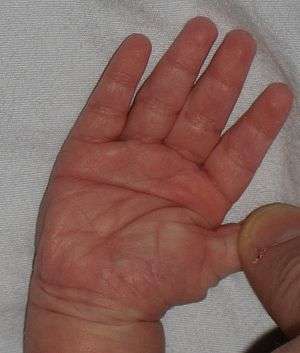Single transverse palmar crease
| Single transverse palmar crease | |
|---|---|
 | |
| Single transverse palmar crease on an infant's hand | |
| Classification and external resources | |
| ICD-9-CM | 757.2 (CDC/BPA 757.200) |
| MedlinePlus | 003290 |
In humans, a single transverse palmar crease is a single crease that extends across the palm of the hand, formed by the fusion of the two palmar creases (known in palmistry as the "heart line" and the "head line") and is found in half of people with Down Syndrome.[1][2][3] It is also found in 1.5% of the general population in at least one hand.[4]
Because it resembles the usual condition of non-human simians, it is also known as a simian crease or simian line, although these terms have widely fallen out of favor due to their pejorative connotation.[5]
Medical significance
Males are twice as likely as females to have this characteristic, and it tends to run in families. In its non-symptomatic form, it is more common among Asians and the presence of a single transverse palmar crease can be, but is not always, a symptom associated with abnormal medical conditions, such as fetal alcohol syndrome, or with genetic chromosomal abnormalities, including Down Syndrome (chromosome 21), cri du chat syndrome (chromosome 5), Klinefelter syndrome, Wolf-Hirschhorn Syndrome, Noonan syndrome (chromosome 12), Patau syndrome (chromosome 13), Edward's syndrome (chromosome 18), and Aarskog-Scott syndrome (X-linked recessive), or autosomal recessive disorder, such as Leaukocyte adhesion deficiency-2 (LAD2).[6] A unilateral single palmar crease was also reported in a case of chromosome 9 mutation causing Nevoid basal cell carcinoma syndrome and Robinow syndrome.[7] It is also sometimes found on the hand of the affected side of patients with Poland Syndrome, and craniosynostosis.
Additional images
 Single transverse palmar crease in an adult
Single transverse palmar crease in an adult More common palmar creases in adults
More common palmar creases in adults
See also
References
- ↑ McPherson M.D., Katrina (2004-05-03). "Simian crease". Medical Encyclopedia. United States National Library of Medicine. Retrieved 2006-09-28.
- ↑ "Definition of Simian crease". MedicineNet. MedicineNet, Inc. 2005. Retrieved 2006-09-28.
- ↑ Hammer, edited by Stephen J. McPhee, Gary D. (2010). "Pathophysiology of Selected Genetic Diseases". Pathophysiology of disease : an introduction to clinical medicine (6th ed.). New York: McGraw-Hill Medical. pp. Chapter 2. ISBN 9780071621670.
- ↑ Dar M.D., Hannah (1976-08-06). "Palmar Crease Variants and Their Clinical Significance" (PDF). Medical Encyclopedia. United States National Library of Medicine. Retrieved 2016-10-20.
- ↑ Cooley, W. Carl; Wilson, Golder (2000). Preventive management of children with congenital anomalies and syndromes. Cambridge, UK: Cambridge University Press. p. 147. ISBN 0-521-77673-2.
- ↑ "Leukocyte adhesion deficiency II syndrome, a generalized defect in fucose metabolism". The Journal of pediatrics 134, no. 6 (1999): 681-688. 30 June 1999.
- ↑ "Interstitial deletion of chromosome 9, int del(9)(9q22.31-q31.2), including the genes causing multiple basal cell nevus syndrome and Robinow/brachydactyly 1 syndrome - Springer". Springerlink.com. 2003-02-01. Retrieved 2013-01-10.